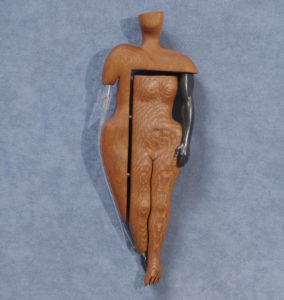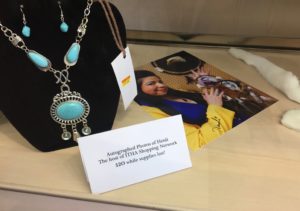An uniquely accessible exhibition in downtown Ottawa includes video screens on which people can be seen using sign language. There are no subtitles or translation, so the majority of visitors — who don’t know sign language — cannot understand what is being said, and must work harder to achieve a routine result, to do something they usually take for granted. This is enlightening, given the nature of the exhibition.
In Constructed Identities, now in the Canada Council for the Arts gallery on Elgin Street, the artist Persimmon Blackbridge uses “mixed media wood-carving with found objects to question how disability is framed as a fracturing of ordinary life rather than a normal, expected part of it.”

A Lacewood Doll on view in the exhibition, Constructed Identities.
The video screens, with people speaking in American Sign Language or Langue des signes québécoise, are there to explain the exhibition to those who use those languages. There are also descriptions in audio, braille, and in plain old English and French text. There are pieces of art hung low, so everyone can get the optimum experience of viewing art at eye level, and there’s even one piece of “tactile” art that people are encouraged to touch, especially those who cannot see. It all puts almost every visitor on even ground, a dedication that in itself is a statement about art and life, and a demonstratively practical component of Blackbridge’s purpose.
Constructed Identities has toured Canada, and is now in the council’s gallery in the lobby of 150 Elgin (think, “the Shopify building”) until June 3. It was the inaugural exhibition for the Toronto-based group Tangled Art + Disability, which describes itself as “an organization committed to cultivating Deaf, Mad and disability arts in Canada.” Tangled Art describes Blackbridge as “a sculptor, writer, curator and performer, as well as being a fiction editor, cleaning lady and very bad waitress.”
That description fits with the exhibition, which is full of figures (dolls?) assembled from many parts of many things — wood, metal, bone, hair, “misc. junk.” It’s like a group of people just walked out of a tiny scrap yard.

Liminal Barbie from the show Constructed Identities.
The figures are attached to boards, loosely grouped but with space of their own to evoke a sense of isolation. None of the figures is perfect, by any ideal of anatomical beauty, but each seems solid, strong, capable. Each seems like the other not despite of their differences, but because of those differences, for if differences are universal, then are we not all the same?
“These figures are awkward and fit together from broken parts,” Blackbridge says in her artist’s statement, “not because we (we people, we strange, ordinary people whose bodies defy the default) are broken, but because we are human — and the human condition is awkward, contradictory, stitched together from disparate pieces. The figures also reflect power and beauty, not because we have in any final way freed ourselves, but because we have strength, grace and wonder, inseparable from our grief, confusion and anger.”
Constructed Identities is a different way of looking at art, and at humanity.
Ursula Johnson’s Truckhouse has a real knack
The Indian Truckhouse of High Art, by Nova Scotia artist Ursula Johnson, has turned Central Art Garage into a shop crammed with cheap “Indian” knick knacks.
Johnson introduced the Truckhouse in 2011 as a “peddler’s booth in the streets of Halifax,” on Oct. 1, the day each year when the Mi’kmaq nation and the Crown resign the 1752 Treaty of Peace and Friendship.
In Central Art Garage (66-B LeBreton St.), Johnson has added video installation and turned the booth into a full shop — she even added a doorbell and neon “open” sign. There are walls and shelves and cabinets of tacky items, from towels to shirts to jewelry to countless, plastic-adorned dream catchers.

Ursula Johnson’s Indian Truckhouse of High Art, at Central Art Garage, manages to be both distressing and fun, and more effective as a result. Photo: Peter Simpson
It may bring to mind Canadassimo, the deceptively straightforward depanneur that Quebec collective BGL built in the Canadian pavilion in Venice and, more recently, at the National Gallery. Johnson’s message, however, is very different than that of the three Frenchmen.
Like some other Indigenous artists working in Canada today (most notably Kent Monkman and Brian Jungen), Johnson is re-appropriating what has been appropriated by consumer culture. She’s gathered her gewgaws to demonstrate “the mass produced commodified market of Indigeneity, while looking at the selling of stereotypes as cultural symbols that is manifested in this day and age of a national identity crisis.”
Central to Johnson’s shop/exhibition are video monitors of the “Indian Truckhouse Shopping Network.” On one screen the hosts are selling the very items that populate the shop, on the other are ITSN customers extolling the life-altering virtues of the trifles for sale.
Johnson has created a retail reproduction that manages to be both disturbing and entertaining —and, if you’ve ever bought any of these “Indian” souvenirs, a bit embarrassing. It continues to April 30.






